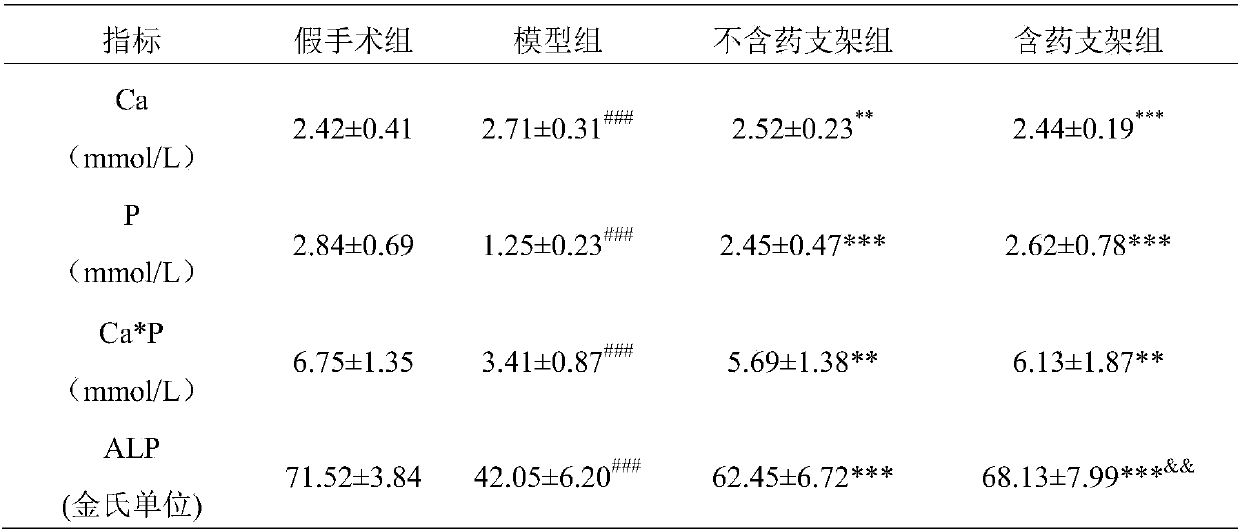3D (Three-Dimensional) printing bracket serving as bone repairing biological material and preparation method thereof
A 3D printing and biomaterial technology, applied in the new field of traditional Chinese medicine, can solve the problems of cumbersome operation and high cost, and achieve the effect of abundant resources, stable components and guaranteeing integrity
- Summary
- Abstract
- Description
- Claims
- Application Information
AI Technical Summary
Problems solved by technology
Method used
Image
Examples
Embodiment 1
[0021] Embodiment 1: the preparation of calcined natural copper
[0022] Take 100g of raw natural copper, particle size 9-10mm, bedding thickness 3cm, put it in a crucible, and calcinate it in a muffle furnace at a temperature of 600°C for 2 hours. Take out the calcined natural copper and immediately pour it into rice vinegar. Once, take it out after quenching with vinegar for 5 minutes, dry it in the air, and crush it through a 100-mesh sieve to obtain calcined natural copper. For every 100kg of natural copper, 30kg of vinegar is used.
Embodiment 2
[0024]A method for preparing β-tricalcium phosphate and calcined natural copper composite 3D printing support: the printing slurry is prepared according to the mass ratio of each component, wherein β-tricalcium phosphate is 80%, calcined natural copper is 10%, sodium polyacrylate 6 %, 4% hydroxymethyl propyl cellulose, weighed calcined natural copper in proportion, added 8 times the amount of water, decocted for 1 hour, decocted twice, filtered, and the filtrate was concentrated to 10g / mL, and mixed with other 3 raw materials Mix, add ultra-pure water, adjust the ratio to keep the volume ratio of raw materials and water at 1:0.5, put it into a high-speed ball mill for grinding for 6 hours, stir and mix with a constant temperature magnetic stirrer at 37°C for 20 minutes, and the speed of stirring is 300rpm to obtain a uniform texture Print paste. Turn on the computer, printer and Solidwords2015 modeling software, connect the computer and printer, put the printing paste into the...
Embodiment 3
[0026] A composite 3D printing bracket of β-tricalcium phosphate and calcined natural copper. The printing paste is 70% of β-tricalcium phosphate, 15% of calcined natural copper, 4% of sodium polyacrylate and methylol Propyl cellulose 6%, weigh calcined natural copper in proportion, add 8 times the amount of water, decoct for 1 hour, decoct twice, filter, concentrate the filtrate to 10g / mL, mix with other 3 kinds of raw materials, add super Pure water, adjust the ratio to keep the volume ratio of raw materials and water at 1:0.5, put it into a high-speed ball mill to grind for 8 hours, stir and mix with a constant temperature magnetic stirrer at 37°C for 25 minutes, and the speed of stirring is 400rpm to obtain a uniform printing paste. Turn on the computer, printer and Solidwords2015 modeling software, connect the computer and printer, put the printing paste into the material tray, install the ink cartridge of the nozzle on the drawing device, load the 3D model data to be prin...
PUM
| Property | Measurement | Unit |
|---|---|---|
| Granularity | aaaaa | aaaaa |
Abstract
Description
Claims
Application Information
 Login to View More
Login to View More - R&D
- Intellectual Property
- Life Sciences
- Materials
- Tech Scout
- Unparalleled Data Quality
- Higher Quality Content
- 60% Fewer Hallucinations
Browse by: Latest US Patents, China's latest patents, Technical Efficacy Thesaurus, Application Domain, Technology Topic, Popular Technical Reports.
© 2025 PatSnap. All rights reserved.Legal|Privacy policy|Modern Slavery Act Transparency Statement|Sitemap|About US| Contact US: help@patsnap.com


